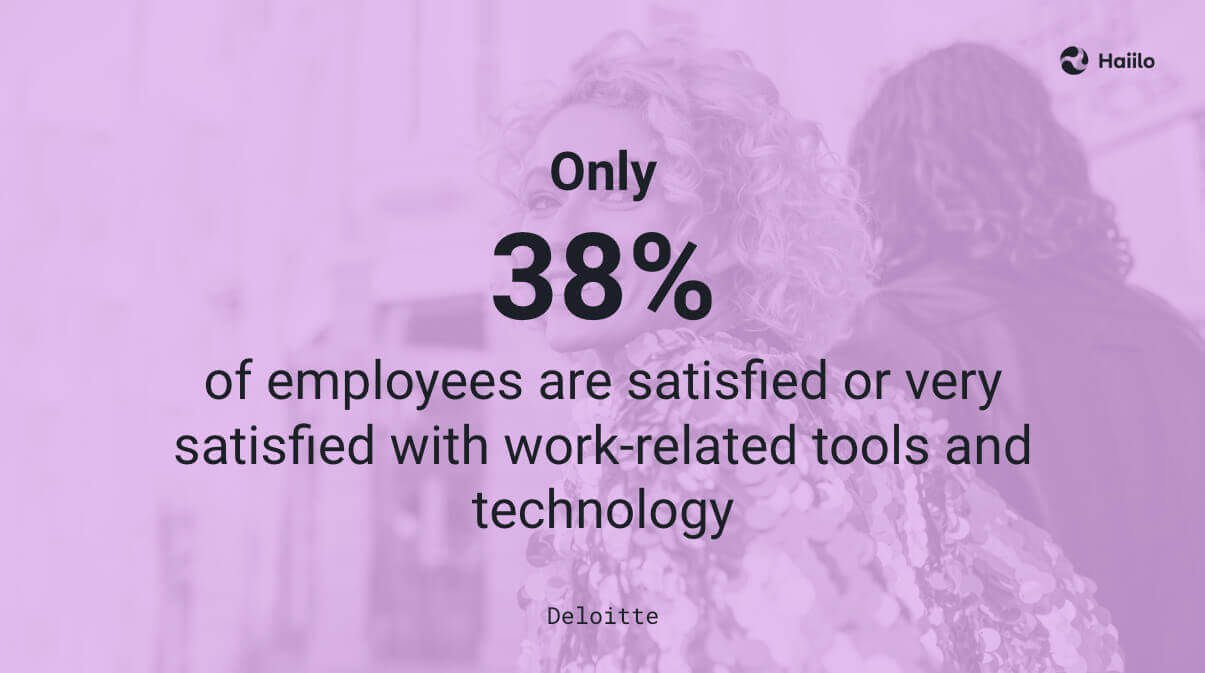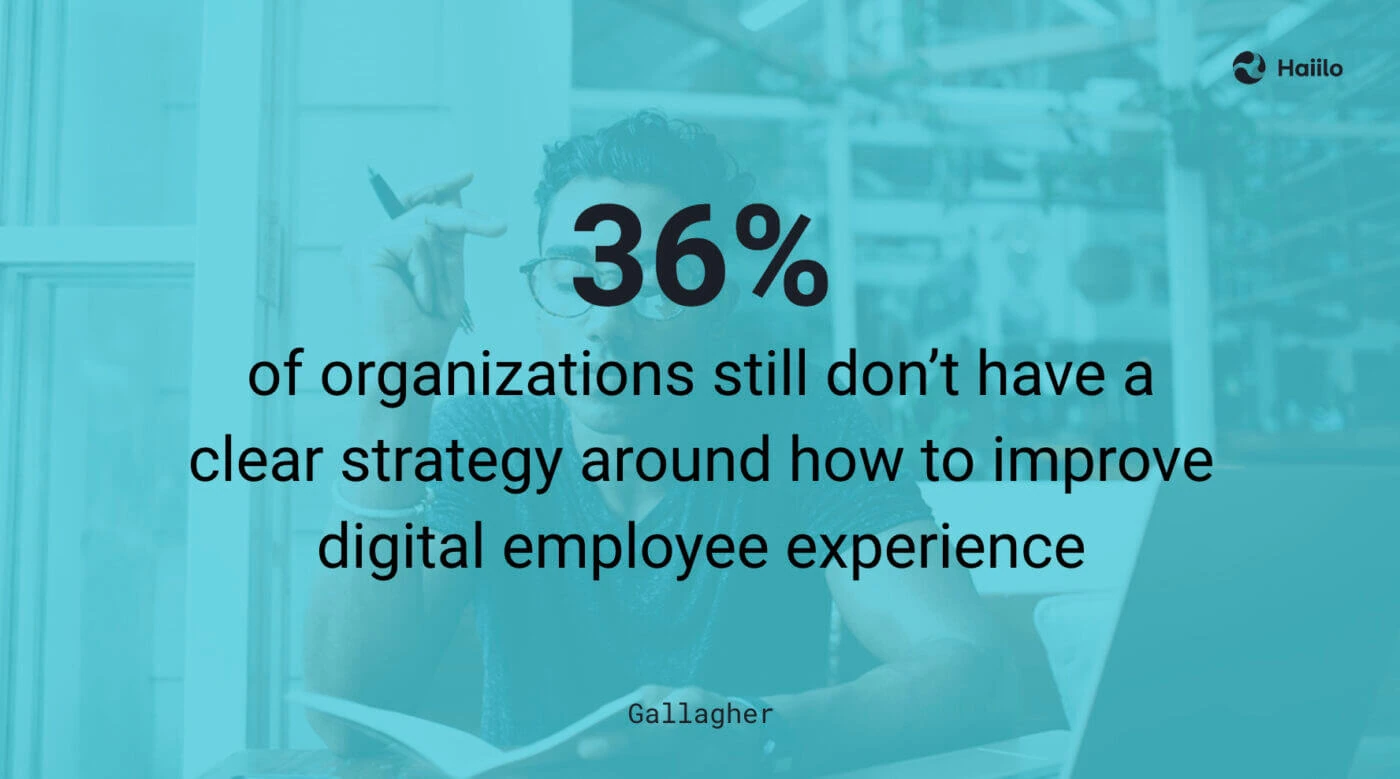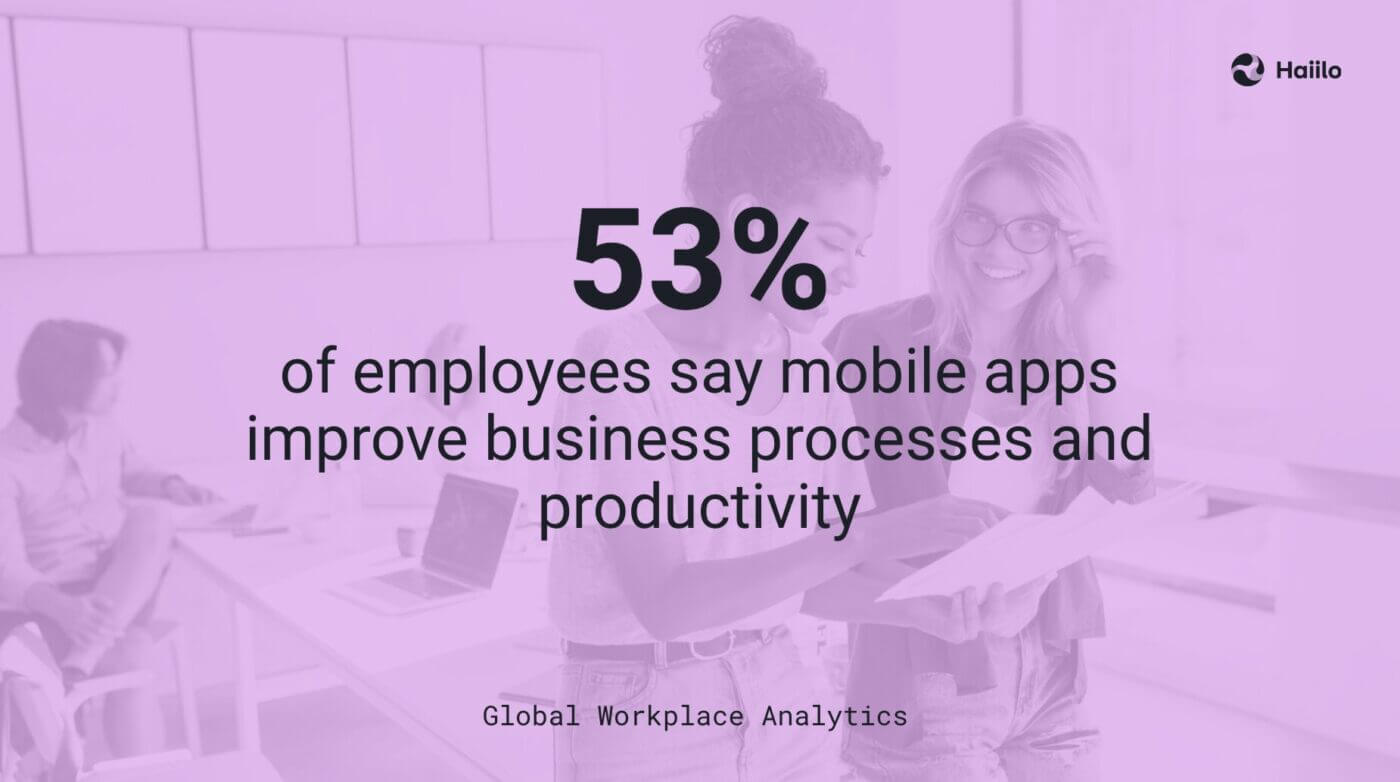Digital workplace experience plays a significant role in shaping the overall employee experience in organizations.
Research shows that technology is crucial to keeping employees happy. 92% of workers claim that access to the right technology that helps them be better and more efficient in their role has an impact on their satisfaction.
Furthermore,
“While data and digital technologies were once enablers of efficiency and cost-cutting, today they’re the engines of innovation and revenue growth,”
says Linda A. Hill, a professor of business administration at Harvard Business School.
On the other hand, research by Deloitte showed that only 38% of employees thought that they were satisfied or very satisfied with work-related tools and technology.

While the goal of digital workplace solutions should always be to improve employee productivity, engagement, motivation, morale, and well-being, that’s not always the case.
In fact, technology can also be a big productivity blocker if not implemented and integrated properly.
It’s important that organizations put effort into understanding how to choose the most appropriate workplace technology, how to adapt it to their business needs and employees’ expectations, and how to get the most value out of each solution.
Only then digital workplace experience can be improved!
Let’s now dig deeper into specific ways to improve the digital employee experience.
Improve digital workplace experience with Haiilo!
1. Understand Your Employees’ Current Digital Experience
Before you even start investigating ways to improve the digital workplace experience, make sure that you understand the current state of it.
The best way to do so is by asking your employees directly. If you are already using an employee survey solution, put together a few simple but well-thought questions that can help you identify your organization’s technology gaps and limitations.
Here are a few examples of employee survey questions:
- Overall, how satisfied are you with our organization’s tech stack?
- Do you feel like you have access to the right technology to perform well on your job?
- Which of our organization’s tools do you find most valuable? Why?
- Which of our organization’s tools do you find least valuable? Why?
- Do you feel like our tech stack is well-integrated?
Answers from these surveys should equip you with valuable insights and actionable recommendations for improvement.
2. Implement the Right Workplace Technology
As nicely put in an article by Harvard Business Review:
“… the technology experiences that employers provide will more or less define the employee experience — technology and workplace tools are, for all intents and purposes, the new workplace. As such, they’re becoming central in attracting and retaining new talent, fostering workplace culture, creating productivity, and more.”
At the same time, according to research, 80–93% of employees don’t think that increased technology has improved business performance.
Furthermore, in Qualtrics research only 30% of employees said their experience with their company’s technology exceeds their expectations.

So workplace technology should be chosen wisely and with employees in mind. In the sea of hundreds of solutions out there, it can be hard to find, evaluate, and implement the right ones.
According to research by Harvard Business Review, technologies that organizations invest the most in are:
- Data management tools (52%)
- Communication/collaboration/learning tools (48%)
- Cloud-based platforms/tools (42%)
- Project and team management tools (41%)
- Remote work tools (41%)
- Task-automation tools (39%)
💡 Take a look at our comprehensive guide about how technology can improve the digital workplace experience and how to choose the best solutions for your company!
3. Make Digital Experience Personalized
According to Gallagher, dissatisfaction with internal technology and channels is one of the biggest problems for larger organizations with more than 500 employees, resulting in poor digital employee experience. Yet, 36% of organizations still don’t have a clear strategy around how to improve it.

One of the most important ways to improve the digital workplace experience is personalization. Unfortunately, most of the content, tools, and information that employees consume on a daily basis is still generic, irrelevant, and disengaging.
In a study of more than 300 communications and HR professionals––71% said employees don’t read or engage with company emails or content, and one of the major reasons is lack of personalization and relevancy.
Luckily, some workplace solutions are built to allow for high levels of personalization, enabling organizations to provide a better workplace experience.
For example, Haiilo’s intranet enables HR and Internal Communications professionals to create and distribute hyper-personalized and engaging content to every employee. Robust internal audience segmentation makes it easy to deliver content based on employees’ preferences, departments, job functions, locations, and many other criteria.
4. Enable Employees to Stay Connected
Today, employees want to be connected to their peers even when they are physically dispersed. They want to have a sense of belongingness and feel like they are a part of a community.
According to APA’s 2023 Work in America workforce survey, 94% of respondents reported that it’s somewhat or very important to them that their workplace be somewhere they feel they belong.

Enabling employees to stay connected and easily collaborate with each other plays a critical role in creating a sense of belonging, and the right technology can help!
Many of today’s workplace tech is designed to enable team communication and drive collaboration. Take project management tools, document management solutions, enterprise social media platforms, or CRM solutions. You will soon realize that most of them come with various collaboration features and functionalities.
Because people are used to using technology to connect with people in their private lives, they expect the same experience in the workplace.
5. Pay Attention to Your Mobile Workforce
Oftentimes, frontline and mobile workers don’t have the same level of access to all the workplace tools, and accessibility plays a critical role in shaping a better digital workplace.
According to research, 20-25% of the global workforce telecommutes on a regular basis and 50% of the workforce is made up of front-line workers such as grocery store clerks, nurses, cleaners, warehouse workers, and bus drivers, among others.
Consequently, around 53% of employees say mobile apps improve business processes and productivity.

So when you are looking for digital solutions for your workplace, make sure that they offer native employee apps and are optimized for those who work on the go.
💡 Related: What is an Employee Engagement App and Why Your Company Needs One
6. Integrate Your Organization’s Tech Stack
According to research, 70% of workers report having to enter the same data in multiple systems to get their job done, and the main culprit for that is a lack of proper integrations between the solutions.
In another survey by Harvard Business Review Analytic Services, 326 executives were asked to choose the most important changes their organizations needed to make to succeed at digital acceleration. 49% picked integrating technologies into a more seamless system.
As nicely put by Deloitte,
“By integrating the technologies that employees use, the digital workplace breaks down communication barriers, positioning you to transform the employee experience by fostering efficiency, innovation and growth. The key to success, however, lies in the effective implementation of a digital workplace strategy capable of driving true cultural change.”
Also, U.S. employees change through an average of 13 apps 30 times per day, according to Asana’s Anatomy of Work Index 2021 report. And 26% of surveyed employees say app overload makes them less efficient at work.
So when choosing technology for your organization, make sure that it integrates with other core systems your employees use daily. You can either look for naive integrations or open APIs to easily build your own.
7. Test with AI
AI-powered workplace technology can significantly improve the overall employee experience and boost employee productivity.
Let’s take internal communications as an example.
Advanced internal communications platforms leverage AI to analyze user activity, understand employee interests, and predict future engagement. Based on data, communicators can identify specific employee profiles, create segments (based on locations, job functions, departments, and many others), and get recommendations around what type of content employees are likely to engage the most with. As a result, every employee gets served content that relates to them, exactly like they do on their favorite social media platform.
Furthermore, AI can significantly improve employees’ experience related to information search – one of today’s biggest productivity killers in every organization. Using AI, Haiilo generates responses instead of links to resources and documents, enabling everyone to find concrete answers straight from the company’s content and knowledge repositories.
Last but not least, Haiilo allows internal communicators to create content 10 times faster, allowing them to put more time and effort into real people’s problems and things robots can’t do!










